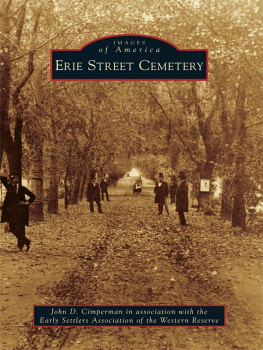Published by The History Press
Charleston, SC
www.historypress.com
Copyright 2021 by Bill Bleyer
All rights reserved
Copyright 2021 by John Cuevas All rights reserved
First published 2021
e-book edition 2021
ISBN 978.1.43967.313.3
Library of Congress Control Number: 2021937139
print edition ISBN 978.1.46715.015.6
Notice: The information in this book is true and complete to the best of our knowledge. It is offered without guarantee on the part of the author or The History Press. The author and The History Press disclaim all liability in connection with the use of this book.
All rights reserved. No part of this book may be reproduced or transmitted in any form whatsoever without prior written permission from the publisher except in the case of brief quotations embodied in critical articles and reviews.
INTRODUCTION
The Old Biloxi Cemetery holds many secrets. The moss-draped oaks with twisted trunks and broken limbs stand watch over myriad tombs that date back to the 1800s. The cemetery is one of the oldest and most historic graveyards from Mobile to New Orleans. But like so many others, the old cemetery has fallen victim to the ravages of time and neglect. Its location, within walking distance of the gulf, has left the graves particularly vulnerable to the elements. Many of the tombs have suffered from the fierce storms that have battered the aging structures for over a century.
After Hurricane Katrina in 2005, one of the most powerful storms to hit the Gulf Coast, bones were strewn about the cemetery, with little respect for the dead. Headstones were broken, and concrete copings were shifted into unnatural shapes or completely destroyed. Some of the beautiful moss-draped oaks that had offered a shady respite from the blistering sun were ripped from their roots, toppling onto some of the very graves they had protected for generations. The fence that had served as a boundary between the peaceful land of the dead and the hectic world of the living was completely demolished, leaving pieces of brick and wrought iron strewn from the cemetery to the waters edge. The Old Biloxi Cemetery was ripped apart like it had never been before, and many questioned whether it could ever be put back together. The condition of the cemetery was particularly disturbing, as it is the resting place of some of the areas most prominent and historical figures.
The Old Biloxi Cemetery was ripped apart by Hurricane Katrina. Photograph by John Cuevas.
The Old Biloxi Cemetery is the resting place of some of the areas most prominent and historical figures. Photograph by John Cuevas.
The oldest upright, two-vault platform tomb in the Old Biloxi Cemetery is the resting place of Juan de Cuevas, known in coast history as the Hero of Cat Island. Over the years, the old Cuevas tomb has suffered like many of the others. Some of the most devastating damage to the structure occurred during hurricane Camille in 1969, when the marble tablet that covered the entrance was cracked and broken in half. Areas of plaster that covered the sides of the tomb were chipped away. The mortar between the joints had crumbled, leaving many of the bricks loosely stacked, with some missing completely.
The oldest upright, two-vault platform tomb in the Old Biloxi Cemetery is the resting place of Juan de Cuevas, the hero of Cat Island. Photograph by John Cuevas.
The old Cuevas tomb suffered devastating damage during hurricane Camille in 1969. Photograph by John Cuevas.
Recently, several concerned members of the Cuevas family recognized that something had to be done to save the old structure from its worsening condition. A group called the Descendants of Juan de Cuevas Family Association was formed for the purpose of saving one of the oldest and most historic tombs in the Old Biloxi Cemetery from further deterioration. The members obtained a grant from the Mississippi Gulf Coast National Heritage Area, along with contributions from family members and friends, to finance the project. Nick Black of NOLA Cemetery Renewal, a prominent expert in tomb restoration from New Orleans, was employed to save the Cuevas tomb.
The old vault, which had been closed since the last burial over one hundred years ago, had to be reopened in order to complete the restoration. To protect and preserve the ancient remains inside the tomb, Dr. Marie Danforth, a professor of anthropology at the University of Southern Mississippi, along with her team of devoted researchers, were called in to carefully remove what was left of Juan de Cuevas and his wife, Marie. Riemanns, a local funeral home, offered to store the remains while the restoration work was being completed.
The project meant that the old tomb had to be virtually reconstructed. No tomb restoration of this magnitude and with this attention to detail has ever been undertaken on the Mississippi Gulf Coast, and definitely, no tomb restoration has ever been so meticulously documented. Professional photographers Jason Taylor and Chris Cahill were charged with taking a step-by-step photographic record of the restoration process. In addition, Cahill videotaped the complete projectfrom the beginning to the endto produce a future documentary.
During the removal of the remains, a shocking secret was discovered. The tomb that, for over a century, was believed to only contain the remains of Juan de Cuevas and his wife was found to also contain the remains of a twenty-seven-year-old woman and a child that was estimated to be about five years old. Who was this mystery woman and infant? What was their connection to the Cuevas family? Why were they in the tomb? These are some of the intriguing secrets in the Old Biloxi Cemetery.
To understand the importance of the Juan de Cuevas tomb restoration, one must understand the significance of the Ladner/Cuevas family to the history of the greater Gulf Coast region. Juan de Cuevas is arguably one of the best-known settlers to have ever lived on the coast. His influence on the area goes far beyond his ownership of Cat Island and his legendary actions in the War of 1812; Juan de Cuevas is more importantly the patriarch of the largest founding family in South Mississippi. The connection of so many to Cat Island and Juan de Cuevas is a cultural phenomenon.














